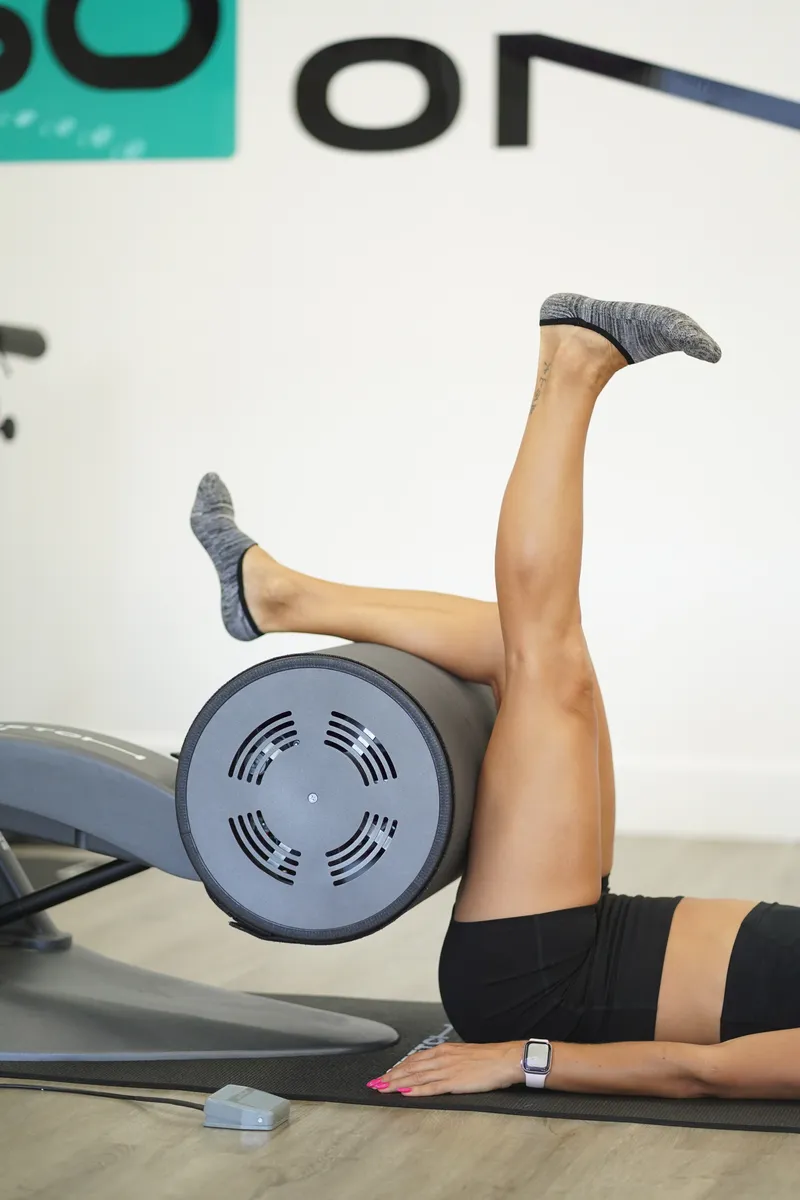For athletes, stretching is a key element of the training process.
Vibro-stretching allows you to:
• Increase range of motion, which is especially important in sports such as tennis, soccer, gymnastics, dance, etc.
• Reduce muscle tension after intense loads, preventing chronic injuries.
• Prepare muscles for exertion: warming up with BMS improves elasticity and reduces the risk of strains and tears.
• Increase overall training efficiency: using vibration machines helps improve results in less time, which is especially important for professionals.
⸻
Why Do Athletes Choose Vibro-Stretching?
1. Increase in Muscle Strength:
Research has shown that the use of vibro-stretching increases muscle strength by 16.5%, significantly higher than conventional training (10.6%).
2. Accelerated Recovery:
Fifteen-minute vibro-stretching sessions twice a week reduce swelling, relieve muscle tension, and restore mobility after injuries. This enables faster return to full training.
3. Reduced Risk of Injury:
Vibro-stretching improves blood circulation and tissue elasticity, reducing the likelihood of microtrauma and overuse injuries.
4. Work with Deep Muscle Layers:
Thanks to vibration amplitude (1–6 mm) and frequency (up to 40 Hz), vibro-stretching reaches muscle groups that are difficult to target with traditional methods.
⸻
How Does It Help Athletes?
• Increased power and endurance:
Vibro-stretching enhances the ability of muscles to withstand high loads, helping athletes stay at peak performance.
• Faster recovery after competitions:
After intensive exertion, vibro-stretching accelerates muscle recovery, which is critical with a tight competition schedule.
• Optimization of the training process:
Vibro-stretching improves training efficiency, reduces recovery time, and lowers the risk of overtraining.
⸻
Scientific Basis and Proven Effectiveness
Journal of Bone and Mineral Research reported:
• Increase in muscle strength: +16.5%.
• Improvement in joint mobility after just 6–8 weeks of use.
Support for tissue health:
• Improved circulation and reduced swelling.
• Accelerated healing of microtraumas.
Vibro-stretching is not just stretching performed with a special technique — it is a science, long established into theoretical concepts and practical systems. Years of research demonstrate its growing popularity in athletic preparation and recovery.
• In the Journal of Sports Sciences, it was proven that vibration therapy after strength training reduces muscle soreness and accelerates relaxation — crucial for athletes who must stay in shape 24/7.
• In Physical Therapy in Sport, participants using vibration devices during stretching showed significantly greater improvements in flexibility compared to those who used classical methods.
• In the Journal of Strength and Conditioning Research, it was noted that vibration therapy after exercise reduces cortisol (the stress hormone) levels and promotes faster recovery.
• An International Journal of Psychophysiology study showed that vibration therapy can significantly reduce stress levels and improve participants’ overall mood. This aligns with practical experience, confirming that vibro-stretching positively impacts psycho-emotional health, reducing stress, anxiety, and fatigue, while promoting endorphin release.
Further studies:
• A team led by V.Ya. Kulakevich conducted experiments showing that vibro-stimulation helps gymnasts and Greco-Roman wrestlers increase strength. Their research confirmed the method’s effectiveness in enhancing power qualities and athletic performance.
• S. Bosco and colleagues studied vibration training durations from 10 days to several months. Results showed significant strength gains at the early stages of the experimental period. Similar conclusions were drawn across multiple studies.
An interesting comparison:
• The effect of 100 minutes of vibro-stretching is equivalent to performing 200 drop jumps from 60 cm height twice a week for 12 months. In other words, one session on a vibration machine equals 5–6 regular training sessions.
Scientific evidence confirms that vibro-stretching is an effective and unique method that combines the benefits of vibration therapy and traditional stretching techniques. Its application significantly improves physical condition, flexibility, recovery, and psycho-emotional well-being — making it a valuable tool in sports and rehabilitation.
Additional research from Kent State University demonstrated that vibro-stretching significantly improves flexibility and reduces spinal stiffness in athletes.
• Source: “Effect of Biomechanical Muscle Stimulation: Ankle range of motion and perceived ankle stiffness in injured, college-athletes.” — Kimberly S. Peer, Danielle Knapp, Jacob Barkley.
Another experiment confirmed that the BMS method improves recovery and hamstring flexibility in injured athletes.
• Source: “Effect of Biomechanical Muscle Stimulation: Hamstring flexibility and perceived tightness in injured, college-aged athletes.” — Kimberly S. Peer, Danielle Knapp, Jacob Barkley.
⸻
For professional athletes seeking to improve results and minimize recovery time, vibro-stretching has become an indispensable tool. This technology helps reach a new level in sports, supporting the health of muscles and joints even under extreme loads.
Prepared by Hanna Turchak — founder and managing partner of the StretchOn project, three-time World Champion, multiple European Champion in modern choreography, and expert in innovative methods of flexibility and recovery.
